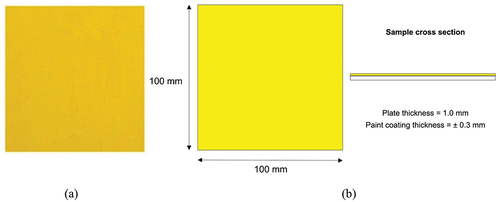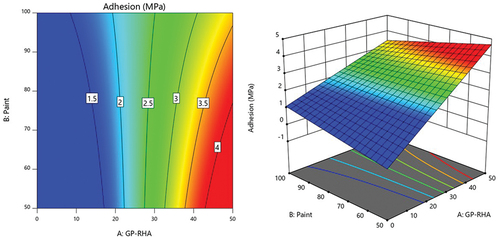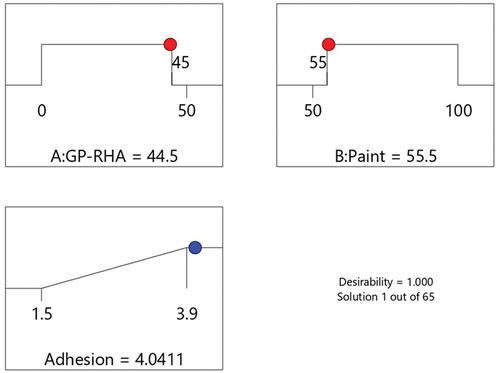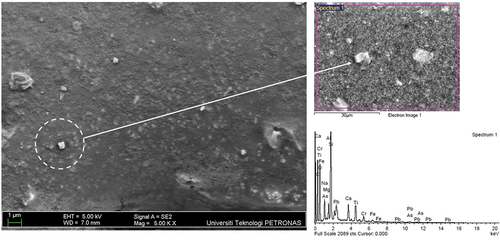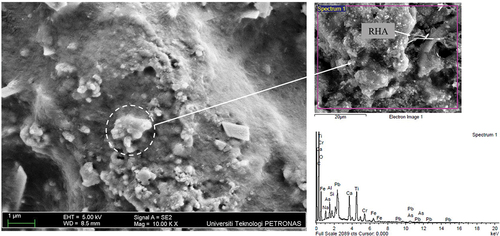ABSTRACT
Ensuring strong adhesion, especially under varying environmental conditions, is a significant challenge in the field of coating technology. This research aims to enhance alkyd paint adhesive strength by incorporating rice husk ash-based geopolymer (GP-RHA) as a filler. Response Surface Methodology (RSM) technique was employed to systematically study the impact of GP-RHA levels on the adhesive strength of alkyd coatings under dry and wet conditions. The morphology of the coatings was analyzed using SEM-EDX. In dry pull-off test, the incorporation of GP-RHA in alkyd coatings led to an improvement in adhesive strength with the highest recorded adhesive strength of 3.9 MPa at a ratio of 41.67% wt. GP-RHA and 58.33% wt. alkyd paint. However, this higher proportion of GP-RHA resulted in the formation of a larger pore sizes hybrid coating, further causing water infiltration into the coating’s pore structure in wet pull-off test. Outcomes of this research showed the promising potential of GP-RHA filler in alkyd paint formulations to enhance adhesion. These findings offer valuable insights into the development of coatings utilizing agro-waste as a filler to improve its adhesive properties.
摘要
确保强附着力,特别是在不同的环境条件下,是涂层技术领域的一个重大挑战. 本研究旨在通过加入稻壳灰基地质聚合物(GP-RHA)作为填料来提高醇酸涂料的粘合强度. 采用响应面法(RSM)技术,系统地研究了GP-RHA水平对醇酸涂料在干湿条件下粘合强度的影响. 使用SEM-EDX对涂层的形态进行了分析.在干剥离试验中,在醇酸涂料中加入GP-RHA导致粘合强度的提高,在41.67%wt.G-RHA和58.33%wt.醇酸涂料的比例下,记录的最高粘合强度为3.9MPa. 然而,这种更高比例的GP-RHA导致形成更大孔径的混合涂层,在湿剥离测试中进一步导致水渗透到涂层的孔结构中. 这项研究的结果表明,GP-RHA填料在醇酸涂料配方中具有提高附着力的潜力. 这些发现为利用农业废弃物作为填料来提高其粘合性能的涂料的开发提供了宝贵的见解.
Introduction
Rice husk (RH) is available abundantly in Malaysia and is regarded as an agricultural waste product. It is normally burnt in open air or landfill, leading to air pollution (Pode Citation2016). From the perspectives of economics and the environment for a sustainable developing nation, one of the ways to eliminate the abundance of RH waste is by fully utilizing these wastes in the main streams of production (Sharma et al. Citation2020). In recent years, the uses of RH has gained a lot of attention as a reinforcement in polymer composites owing to its abundance and renewability. A study conducted by Shaikh et al. (Citation2019) examined the impact of rice husk ash (RHA) and silicon carbide (SC) as reinforcements in aluminum matrix composites (AMC). The results indicated that the inclusion of RHA and SC increased the hardness and wear resistance of the AMC by approximately 33%. Another study found that incorporating RHA particles into aluminum using friction stir processing improved wettability and interfacial bonding with the aluminum matrix (Dinaharan et al. Citation2023). Similarly, Surappa and Surappa (Citation2008) observed that the wear and friction properties of aluminum alloy composites were affected by the particle sizes of RHA in a study on dry sliding wear behavior using the stir cast method. In contrast to composite synthesis, coating material is synthesized mainly by dielectric discharges or application of a thin film of functional material to a substrate. While composite synthesis and coating synthesis are distinct processes, they serve the same purpose to enhance the overall performance of materials. Recently, researchers have explored the addition of natural fiber-based additives or fillers to coatings in order to enhance their mechanical and anti-corrosion properties (Kampa, Sadowski, and Królicka Citation2022; Saba et al. Citation2016). A recent study by Alshahrani and Prakash (Citation2022) demonstrated the successful use of thermo-chemical method to synthesize a bio-based epoxy-RHA coating. The findings revealed that incorporating silica from RHA resulted in enhanced tensile and flexural properties of the epoxy coating. Another study by Kumar et al. (Citation2023) reported that a bio-based vanillin epoxy (VE) synthesized from the lignin-derived vanillin mixed with thermoset resin showed excellent adhesion strength of 13.93 MPa.
Geopolymer has gained significant attention in recent years for their potential applications and commercial value across various fields, such as cement, concrete and resin (Jiang et al. Citation2020). Geopolymers are produced through geochemistry or a synthesis process comprising networks of inorganic molecules (Davidovits Citation2017). The synthesizing process between aluminosilicate sources and alkaline silicate solution then forms a hardened binder possessing exceptional thermal, mechanical and physical properties (Abdullah et al. Citation2022; Wu et al. Citation2019). These remarkable characteristics have led to its widespread use in numerous industrial applications. Studies by Ramadhansyah et al. (Citation2012) and Abdullah et al. (Citation2021) provided substantial evidence that RHA-based geopolymer can be a reliable solution for developing durable coating materials with exceptional thermal resistance and remarkable strength properties.
Alkyd coatings are widely used in the coating market today but the main issue in an alkyd coating is that the resin system can be negatively impacted by alkali, causing it to become malleable and tacky from a process known as saponification (Vevere et al. Citation2020). Thus, it is very important to thoroughly address this issue and emphasize the necessity of using an additive or filler to improve the adhesion strength of alkyd coating. The novelty of this research is the improvement of the adhesion strength of alkyd coating by utilizing RHA-based geopolymer (GP-RHA) as a filler. The impact of the content of fillers (GP-RHA) on the adhesive strength of alkyd coatings under dry and wet conditions, which remained not widely explored before, is also studied. Simultaneously, the microstructural characteristics of alkyd paint are discussed to evaluate the influence of adding GP-RHA on the coating surface and adhesive strength under dry and wet conditions.
Materials and methods
Experimental design based on response surface method
This study analyzed two key factors: A (GP-RHA) and B (paint); each was replicated three times at different levels (−1, −0.5, 0, 0.5 and 1). The Central Composite Design (CCD) was chosen for its improved precision and prediction accuracy in the experimental region. An experimental design using the Response Surface Method (RSM) with a total run of 39 experiments was conducted following a two-level factorial design. shows the experimental range and levels of CCD for both control variables.
Table 1. Experimental range and levels of central composite design.
Raw materials
The rice husk (RH) used in this research was obtained from the Oryza sativa species, commonly known as Asian rice. The rice husk ash (RHA) was produced by incineration process at a temperature of 600°C for two hours using WiseTherm Digital Muffle Furnace (Daihan, Gangwon, Korea). The main compositions of the RHA are silicone dioxide (90.58%), potassium oxide (0.82%), aluminum oxide (0.06%), iron oxide (0.03%) and calcium oxide (0.02%). RHA was then ground using RT-02A (Mill Powder Tech, Tainan, Taiwan) and sieved with Endecotts Laboratory Test Sieve (Endecotts, London, UK) to achieve an average particle size below 65 μm.
RHA-based geopolymer hybrid coating sample preparation
The GP-RHA additive was synthesized by combining an alkaline activation solution of sodium silicate (Na₂SiO₃) and sodium hydroxide (NaOH) with RHA. In this study, a concentration of 8 M NaOH was used, while the liquid-to-solid ratio was set at 2.5 based on previous studies by Abdullah et al. (Citation2021) and Mohd Basri et al. (Citation2020), resulting in increased mechanical strength and yield stress in the geopolymer samples. illustrates the design composition for GP-RHA, whereas displays the mild steel as the substrate specimen and its schematic diagram for this research.
Table 2. Design compositions of GP-RHA.
Microstructure analysis
The microstructure of GP-RHA hybrid alkyd coating was examined using microscopy techniques, specifically scanning electron microscopy (SEM). The Hitachi S-3400 N (Hitachi, Tokyo, Japan) instrument was used to conduct SEM imaging at an accelerating voltage of 15 kV. The elemental composition of the GP-RHA alkyd coating was analyzed using Scanning electron microscopy-energy dispersive X-ray analysis (SEM-EDX).
Pull-off adhesion test
In this research, the Elcometer 106 pull-off adhesion tester was utilized following the ASTM D4541 standard to determine the adhesion strength between substrate and coating. Two types of pull-off adhesion tests were conducted: dry and wet conditions pull-off. The dry pull-off test included 39 samples from a two-level factorial, with the best and worst samples being subjected to further testing under a wet condition pull-off adhesion test. These two samples were immersed 500 h in 3.5 wt.% NaCl solution before being tested for their adhesive strength once dried. This test was conducted to simulate the coating’s durability in an open environment.
Results and discussions
presents the complete design composition and adhesion strength values for the geopolymer hybrid coating samples. The geopolymer hybrid coatings were designated as GPHC.
Table 3. Design composition and adhesion value for dry pull-off adhesion test.
Statistical analysis and model equation
The statistical significance of the regression model and its terms were assessed using sequential F-test and lack of fit test. The findings in highlight the estimated effects and coefficients related to adhesion strength in the pull-off adhesion test. The results revealed that all factors, as well as interaction effects were statistically significant at a confidence level below <0.0500. Additionally, high R-squared values (R2 = 93.27% & adjusted R2 = 92.18%) were found, suggesting that a significant amount of variation in response could be attributed to the examined factors.
Table 4. ANOVA analysis for pull-off adhesion strength.
The adhesion strength of paint containing GP-RHA can be evaluated using regression models, which help in determining how different parameters affect the adhesive performance of the paint represented as YAS.
Regression models for adhesion strength were respectively expressed in terms of actual factors.
YAS = 2.26 + 1.79 A + 0.00B − 0.6316 AB
Analysis of interaction effects on adhesive strength
The effects of GP-RHA and alkyd paint compositions on coating adhesion strength were examined using regression models in ANOVA. Visual representation of these findings using contour plots is shown in , revealing that higher levels of GP-RHA improved the adhesion strength of the coating. Specifically, within ranges from 38 wt. % to 50 wt. % for A and from 43 wt.% to 77 wt.% for B, an adhesion strength level of up to 4 MPa was observed.
Model validation
The optimization process to achieve coating maximum adhesive strength was conducted using ANOVA. The adhesive strength goal was set with a target value of 3.9 MPa, while a minimum acceptable value of 1.5 MPa was set to predict its maximum adhesive strength. illustrates the predicted ideal conditions and corresponding responses analyzed to assess adhesion strength in detail. The optimal operational parameters affecting adhesive properties were estimated to be at 41.67 wt.% GP-RHA and 58.33 wt.% paint; under these optimized circumstances, statistical modeling techniques predicted an expected increase in adhesion strength up to approximately 4.04 MPa. The optimization desirability score scored one (1.000), indicating that all variables complied with set targets toward achieving maximal bonding efficacy concerning this study’s objectives.
Coating adhesion behaviour in dry pull-off adhesion
The design composition and adhesive strength values for samples GPHC26 and GPHC29 were further discussed due to their best and worst performance in the adhesion test and compared to the control sample (Alkyd) performance for adhesive properties. shows the ratio and responses for each sample. In comparison with the control sample (Alkyd), the adhesion strength increased from 1.4 to 3.9 MPa for sample GPHC26 and 1.4 to 1.5 MPa for sample GPHC29, which indicated 2.5 MPa and 0.1 MPa adhesion strength improvement for samples GPHC26 and GPHC29, respectively.
Table 5. Ratio and responses for sample alkyd, GPHC26 and GPHC29 for pull-off adhesion test.
To supplement the dry pull-off adhesion result, the microstructure properties of the samples GPHC26 and GPHC29 were then analyzed using SEM. demonstrate SEM images for samples GPHC26 and GPHC29, respectively. The analysis revealed that sample GPHC26 had a smoother surface with a larger dense gel matrix consisting of well-connected structures comprising glassy phases and fewer unreacted particles compared to sample GPHC29. Additionally, no visible crack formations were observed on the coating’s surface in sample GPHC26.
Figure 4. SEM micrograph of the sample GPHC26 surface (a) at 500× of magnification (b) at 5000× of magnification.
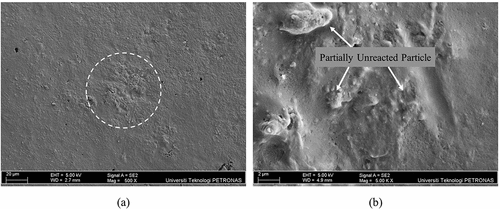
Figure 5. SEM micrograph of the sample GPHC29 surface (a) at 500× of magnification (b) at 5000× of magnification.
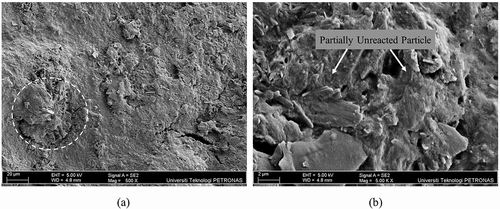
Upon examining the sample GPHC29 coating surface, it was apparent that there were several cracks and partially unreacted particles presented on the rough surface. These findings are consistent with previous research by Grillet et al. (Citation2012), which highlights that crack formation can significantly weaken geopolymer structures in the GP-RHA hybrid coatings, leading to poor adhesion strength. In addition, incomplete geopolymerisation process in GPHC29 caused higher unreacted particles which resulted in poor adhesion bonding to substrate surface. Similar outcomes were found by Rodriguez et al. (Citation2013), which reported that poor adhesion bonding was caused by the lower degree of dissolution and gel formation resulted in a smaller contact area between the gel matrix and substrate surface.
The cross-sectional SEM images of samples GPHC26 and GPHC29 were examined in further detail to investigate the behavior of the coating microstructure after undergoing the pull-off adhesion test, as shown in . Upon examination of sample GPHC26 shown in , it was seen that no crack formation occurred on the cross-section of the coating surface, and there was no weak adhesion area due to good wettability between the GPHC with steel substrate. On the other hand, observations made from analyzing sample GPHC29 presented in revealed extensive long and wide cracks formed on its coating cross-section due to poor plastic performance plus weak adhesion zone from poor wettability. This finding aligns with a study conducted by Azadi et al. (Citation2011), which demonstrated that incorporating RHA into paints significantly enhanced their plasticity and wettability, which corroborates with the present findings obtained through SEM analysis.
Figure 6. Cross Section SEM micrograph of the sample GPHC26 (a) at 100× of magnification and (b) at 500× of magnification.
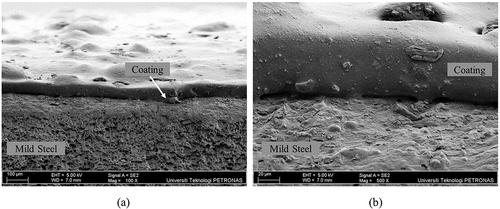
Figure 7. Cross Section SEM micrograph of the sample GPHC29 (a) at 100× of magnification and (b) at 500× of magnification.
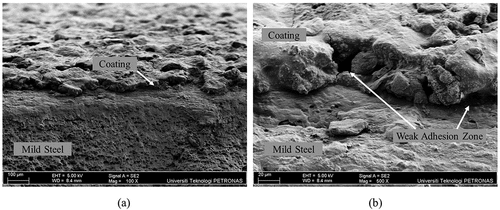
shows the SEM-EDX analysis of sample GPHC26, which aimed to characterize the geopolymerisation process on the surface of GP-RHA hybrid coating. Spectrum 1, collected from the particle in sample GPHC26 as in , showcased a higher dissolution, more compact and dense gel formation on the coating surface, which resulted in a higher contact area between the gel matrix and substrate surface and can lead to good adhesion bonding. Meanwhile, sample GPHC29 in demonstrated a needle-shaped irregular particle identified as RHA. This observation indicated that an incomplete dissolution of RHA particles resulted in rough texture and uneven distribution of the GP-RHA mixtures on GPHC coating.
The difference between GPHC26 and GPHC29 microstructural behavior could be further clarified by the Si/Al ratio in the coating compositions. Rong et al. (Citation2021) reported that the Si/Al ratio is a vital factor affecting the adhesion properties of geopolymers. To supplement this statement, both samples were validated with EDX analysis at Spectrum 1 in . Results showed that sample GPHC26 has a higher Si/Al ratio of 5.69 compared to sample GPHC29 with a ratio of 0.41. Previous studies suggest that increased Si/Al ratio leads to enhanced dissolution, gel formation and denser gel structure (Nath et al. Citation2016). This dense gel matrix facilitated larger contact between it and the substrate surface, thereby improving wetting characteristics and leading to excellent adhesive bonding outcomes as seen in sample GPHC26. The results obtained from the dry pull-off adhesion test revealed that the Si/Al ratio of GP-RHA in the alkyd coating has a significant impact on adhesion strength and showed good agreement with previous studies (Mohd Basri et al. Citation2020; Rong et al. Citation2021).
Table 6. EDX analysis for sample GPHC26 and GPHC29.
Coating adhesion behaviour in wet pull-off adhesion
A wet adhesion test was simulated to study the GPHC characteristic to bind firmly onto a substrate material even under wet environmental circumstances. shows the ratios and adhesion strength for each sample, while shows the comparison results of dry adhesion and wet adhesion. Results indicated that in comparison to dry conditions, the alkyd coating’s adhesion strength in wet environment simulation was reduced by 28.57% (1.4 MPa to 1.0 MPa), as well as sample GPHC26 with 35.90% reduction (3.9 MPa to 2.5 MPa) and GPHC29 with 13.33% reduction (1.5 MPa to 1.3 MPa). All samples showed a reduction trend after being immersed in NaCl solution. However, both samples, GPHC26 and GPHC29, with the addition of GP-RHA, still showed a better adhesive strength compared to alkyd paint. Thus, it can be concluded that the addition of GP-RHA has a significant effect on the coating adhesive strength, even in wet environments.
Figure 10. The pull-off adhesion test result for measuring the dry adhesion and wet adhesion strength.
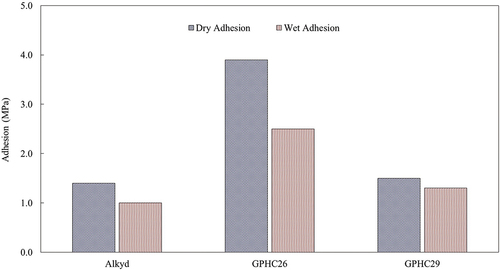
Table 7. Ratio and adhesion strength for sample alkyd, GPHC26 and GPHC29 for pull-off adhesion test.
Visual inspection was done on these samples to study the effect of water immersion on the coating surface and defect. presents the coating visual inspection for sample alkyd GPHC26 and GPHC29. In , it can be clearly seen that alkyd coating exhibited an efflorescence effect with crystalline deposits on the surface, resulting in coating failure. Micro cracks on the coating surface are one the major causes of efflorescence. Moreover, alkyd paint was not a highly water-resistant coating, thus causing water penetration through the paint film and affecting the moisture content in the substrate. Meanwhile for sample GPHC26 in , it can be seen that sample GPHC26 started to swell on the edge part of the specimen due to high water adsorption. The higher ratio of GP-RHA produced a hybrid coating with large pore size, causing water to infiltrate into the pore structure of the coating. Furthermore, the type of precursor used in the study can impact the water resistance of geopolymer. It is important to note that the hygroscopic nature of RHA resulted in high water adsorption rate (Abalaka Citation2013). This phenomenon caused the adhesive strength of sample GPHC26 to be reduced drastically compared to the dry adhesion pull-off test. For sample GPHC29 in , the coating did not show any visual defect. Thus, it can be concluded that the addition of 12.50% wt. GP-RHA improved and protected the alkyd coating from efflorescence effect and water. To support this argument, these three samples were then analyzed under SEM image analysis to analyze the microstructural behavior of the samples after being immersed for 500 h in NaCl solution.
Figure 11. Coating sample after 500 h immersion in 3.5 wt.% NaCl solution showing (a) efflorescent effect with crystalline deposits on the surface of alkyd paint, (b) swelling on on the edge part of GPHC26 specimen and (c) no visual defect on GPHC29.
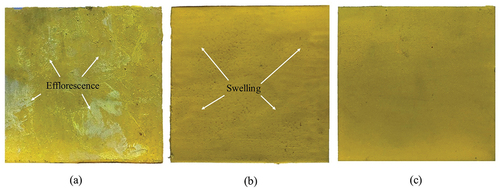
shows SEM images of samples alkyd, GPHC26 and GPHC29 after the wet environment test. It can be seen clearly in for alkyd coating that several cracks occurred on the coating surface, which supports the finding on the formation of efflorescence. These cracks showed that the resin in alkyd was broken down by moisture during the immersion test. Meanwhile, for sample GPHC26 in , the hydrophilic of GP-RHA additives caused the sample to swell due to the capillary transport between gaps (Wang et al. Citation2015). Additionally, some unreacted particles were also observed on the coating surface. In for sample GPHC29, it can be seen that several micropores occurred on the coating surface, which could have fastened the saponification process on the coating. Thus, it can be concluded that the incorporation of GP-RHA additives into alkyd paint enhances the adhesive strength of the coating yet, at the same time, also increases the permeation of water into the coating.
Conclusions
The present study employed Response Surface Methodology (RSM) to identify the significant factors and optimize experiment responses regarding adhesion strength. Based on the analysis, the following conclusions are drawn:
GP-RHA can significantly enhance coating adhesion, with 3.9 MPa representing the highest recorded adhesive strength at a mixture consisting of 41.67% wt. GP-RHA mixed with 58.33% alkyd paint.
SEM analysis revealed that formation of dense gel matrices are crucial factors when seeking optimal adhesive performance results. An increased in GP-RHA content generates a larger portion of dense gel matrix which contributes significantly to high adhesive properties.
The Si/Al ratio of GP-RHA in the alkyd coating has a significant impact on adhesion strength. Higher Si/Al ratio leads to enhanced dissolution, gel formation and denser gel structure while partially unreacted particles of GP-RHA hybrid coating can lead to undesirable outcomes such as poor adhesion strength due smaller contact area between the gel matrix and substrate surface.
The addition of GP-RHA to improve adhesion strength resulted in capillary transport between gaps and swelling of the sample in wet environments, due to its hydrophilic properties. This suggests that while incorporating GP-RHA as a filler can enhance the adhesive strength of alkyd paint, it also increases water permeation.
Utilizing RHA geopolymer has shown promise due to its strong adhesive properties and versatility. Additionally, exploring other by-products or agro-waste with high silica content like palm-oil fuel ash (POFA) and empty fruit bunch (EFB) could be interesting for future studies, as this specific study focuses solely on using RHA to enhance coating’s mechanical properties.
Author’s contribution
“Conceptualization, M.N.A. and F.M.; methodology, M.N.A.; software, M.M.; validation, M.N.A. and F.M.; formal analysis, M.N.A. and T.K; investigation, M.N.A, and F.M.; resources, M.M.; data curation, M.N.A.; writing – original draft preparation, M.N.A.; writing – review and editing, M.N.A. and T.K; visualization, M.N.A.; supervision, M.N.A.; project administration, F.M.; funding acquisition, T.K., T.A.S and M.M.
Research highlights
The influence of GP-RHA as a filler in alkyd coating adhesive strength was investigated.
The results indicate that by incorporating GP-RHA as a filler in alkyd coating significantly improve coating adhesive strength.
The use of RHA geopolymer as a filler in alkyd paint shows great potential due to its impressive adhesive strength and versatility.
Acknowledgments
The authors would like to thank the Department of Aerospace Engineering, Faculty of Engineering, Universiti Putra Malaysia. The authors would also like to acknowledge the support of Universiti Teknologi PETRONAS and Universitas Pertamina under the International Collaborative Research Fund (015-ME0-193). The authors would like to acknowledge the support of Prince Sultan University, Riyadh for paying the Article Processing Charge (APC) of this publication.
Disclosure statement
No potential conflict of interest was reported by the author(s).
Additional information
Funding
References
- Abalaka, A. E. 2013. “Strength and Some Durability Properties of Concrete Containing Rice Husk Ash Produced in a Charcoal Incinerator at Low Specific Surface.” International Journal of Concrete Structures and Materials 7 (4): 287–14. https://doi.org/10.1007/s40069-013-0058-8.
- Abdullah, M. N., F. Mustapha, K. A. Ahmad, M. Mustapha, T. Khan, B. Singh, and T. A. Sebaey. 2022. “Effect of Different Pre-Treatment on the Microstructure and Intumescent Properties of Rice Husk Ash-Based Geopolymer Hybrid Coating.” Polymers 14 (11): 2252. https://doi.org/10.3390/polym14112252.
- Abdullah, M. N., M. Mustapha, N. Sallih, A. Ahmad, F. Mustapha, and A. Dahliyanti. 2021. “Study and Use of Rice Husk Ash as a Source of Aluminosilicate in Refractory Coating.” Materials 14 (13): 3440. https://doi.org/10.3390/ma14133440.
- Alshahrani, H., and V. A. Prakash. 2022. “Thermal, Mechanical and Barrier Properties of Rice Husk Ash Biosilica Toughened Epoxy Biocomposite Coating for Structural Application.” Progress in Organic Coatings 172:107080. https://doi.org/10.1016/j.porgcoat.2022.107080.
- Azadi, M., M. E. Bahrololoom, and F. Heidari. 2011. “Enhancing the Mechanical Properties of an Epoxy Coating with Rice Husk Ash, a Green Product.” Journal of Coatings Technology and Research 8 (1): 117–123. https://doi.org/10.1007/s11998-010-9284-z.
- Davidovits, J. 2017. “Geopolymers: Ceramic-Like Inorganic Polymers.” The Journal of Ceramic Science and Technology 8 (3): 335–350.
- Dinaharan, I., J. A. K. Gladston, J. D. R. Selvam, and T. C. Jen. 2023. “Influence of Particle Content and Temperature on Dry Sliding Wear Behavior of Rice Husk Ash Reinforced AA6061 Slurry Cast Aluminum Matrix Composites.” Tribology International 183:108406. https://doi.org/10.1016/j.triboint.2023.108406.
- Grillet, A. M., N. B. Wyatt, and L. M. Gloe. 2012. “Polymer gel rheology and adhesion.” Rheology 3:59–80. IntechOpen.https://doi.org/10.5772/36975.
- Jiang, C., A. Wang, X. Bao, T. Ni, and J. Ling. 2020. “A Review on Geopolymer in Potential Coating Application: Materials, Preparation and Basic Properties.” Journal of Building Engineering 32:101734. https://doi.org/10.1016/j.jobe.2020.101734.
- Kampa, Ł., Ł. Sadowski, and A. Królicka. 2022. “The Use of Synthetic and Natural Fibers in Epoxy Coatings: A Comparative Mechanical and Economic Analysis.” International Journal of Adhesion and Adhesives 117:103017. https://doi.org/10.1016/j.ijadhadh.2021.103017.
- Kumar, B., S. Adil, and J. Kim. 2023. “Adhesion Improvement of Bio‐Based Epoxy in Environmentally Friendly and High‐Performance Natural Fiber‐Reinforced Composites.” Macromolecular Materials and Engineering 308 (8): 2300003. https://doi.org/10.1002/mame.202300003.
- Mohd Basri, M. S., F. Mustapha, N. Mazlan, and M. R. Ishak. 2020. “Optimisation of Adhesion Strength and Microstructure Properties by Using Response Surface Methodology in Enhancing the Rice Husk Ash-Based Geopolymer Composite Coating.” Polymers 12 (11): 2709. https://doi.org/10.3390/polym12112709.
- Nath, S. K., S. Maitra, S. Mukherjee, and S. Kumar. 2016. “Microstructural and Morphological Evolution of Fly Ash Based Geopolymers.” Construction and Building Materials 111:758–765. https://doi.org/10.1016/j.conbuildmat.2016.02.106.
- Pode, R. 2016. “Potential Applications of Rice Husk Ash Waste from Rice Husk Biomass Power Plant.” Renewable and Sustainable Energy Reviews 53:1468–1485. https://doi.org/10.1016/j.rser.2015.09.051.
- Ramadhansyah, P. J., A. W. Mahyun, M. Z. M. Salwa, B. A. Bakar, M. M. Johari, and M. W. Ibrahim. 2012. “Thermal Analysis and Pozzolanic Index of Rice Husk Ash at Different Grinding Time.” Procedia Engineering 50:101–109. https://doi.org/10.1016/j.proeng.2012.10.013.
- Rodriguez, E. D., S. A. Bernal, J. L. Provis, J. D. Gehman, J. M. Monzo, J. Paya, and M. V. Borrachero. 2013. “Geopolymers Based on Spent Catalyst Residue from a Fluid Catalytic Cracking (FCC) Process.” Fuel 109:493–502. https://doi.org/10.1016/j.fuel.2013.02.053.
- Rong, X., Z. Wang, X. Xing, and L. Zhao. 2021. “Review on the Adhesion of Geopolymer Coatings.” American Chemical Society Omega 6 (8): 5108–5112. https://doi.org/10.1021/acsomega.0c06343.
- Saba, N., M. Jawaid, O. Y. Alothman, M. T. Paridah, and A. Hassan. 2016. “Recent Advances in Epoxy Resin, Natural Fiber-Reinforced Epoxy Composites and Their Applications.” Journal of Reinforced Plastics and Composites 35 (6): 447–470. https://doi.org/10.1177/0731684415618459.
- Shaikh, M. B. N., S. Arif, T. Aziz, A. Waseem, M. A. N. Shaikh, and M. Ali. 2019. “Microstructural, Mechanical and Tribological Behaviour of Powder Metallurgy Processed SiC and RHA Reinforced Al-Based Composites.” Surfaces and Interfaces 15:166–179. https://doi.org/10.1016/j.surfin.2019.03.002.
- Sharma, S., S. Basu, N. P. Shetti, M. Kamali, P. Walvekar, and T. M. Aminabhavi. 2020. “Waste-To-Energy Nexus: A Sustainable Development.” Environmental Pollution 267:115501. https://doi.org/10.1016/j.envpol.2020.115501.
- Surappa, S., and M. K. Surappa. 2008. “Dry Sliding Wear of Fly Ash Particle Reinforced A356 Al Composites.” Wear 265 (3–4): 349–360. https://doi.org/10.1016/j.wear.2007.11.009.
- Vevere, L., A. Fridrihsone, M. Kirpluks, and U. Cabulis. 2020. “A Review of Wood Biomass-Based Fatty Acids and Rosin Acids Use in Polymeric Materials.” Polymers 12 (11): 2706. https://doi.org/10.3390/polym12112706.
- Wang, Z., J. P. Barford, C. W. Hui, and G. McKay. 2015. “Kinetic and Equilibrium Studies of Hydrophilic and Hydrophobic Rice Husk Cellulosic Fibers Used as Oil Spill Sorbents.” Chemical Engineering Journal 281:961–969. https://doi.org/10.1016/j.cej.2015.07.002.
- Wu, Y., B. Lu, T. Bai, H. Wang, F. Du, Y. Zhang, and W. Cai. 2019. “Geopolymer, Green Alkali Activated Cementitious Material: Synthesis, Applications and Challenges.” Construction and Building Materials 224:930–949. https://doi.org/10.1016/j.conbuildmat.2019.07.112.

